HI6006 Strategy Tools: PESTEL, SWOT, Porter's 5 Forces with Examples
VerifiedAdded on 2023/06/12
|7
|1785
|235
Essay
AI Summary
This essay discusses key strategy development tools, including SWOT analysis, PESTLE analysis, and Porter's Five Forces, to evaluate a company's position in the market. It explains the components of each framework, such as the five forces impacting a company (threat of new entrants, power of suppliers, power of buyers, rivalry among existing competitors, and the threat of substitute products), the internal and external factors considered in SWOT (strengths, weaknesses, opportunities, and threats), and the macro-environmental factors assessed in PESTLE (political, economic, social, technological, legal, and environmental). The essay also provides examples of companies like Aldi, Tesla, and Samsung to illustrate the practical application of these tools in strategic decision-making. Desklib offers a range of solved assignments and study resources to help students.
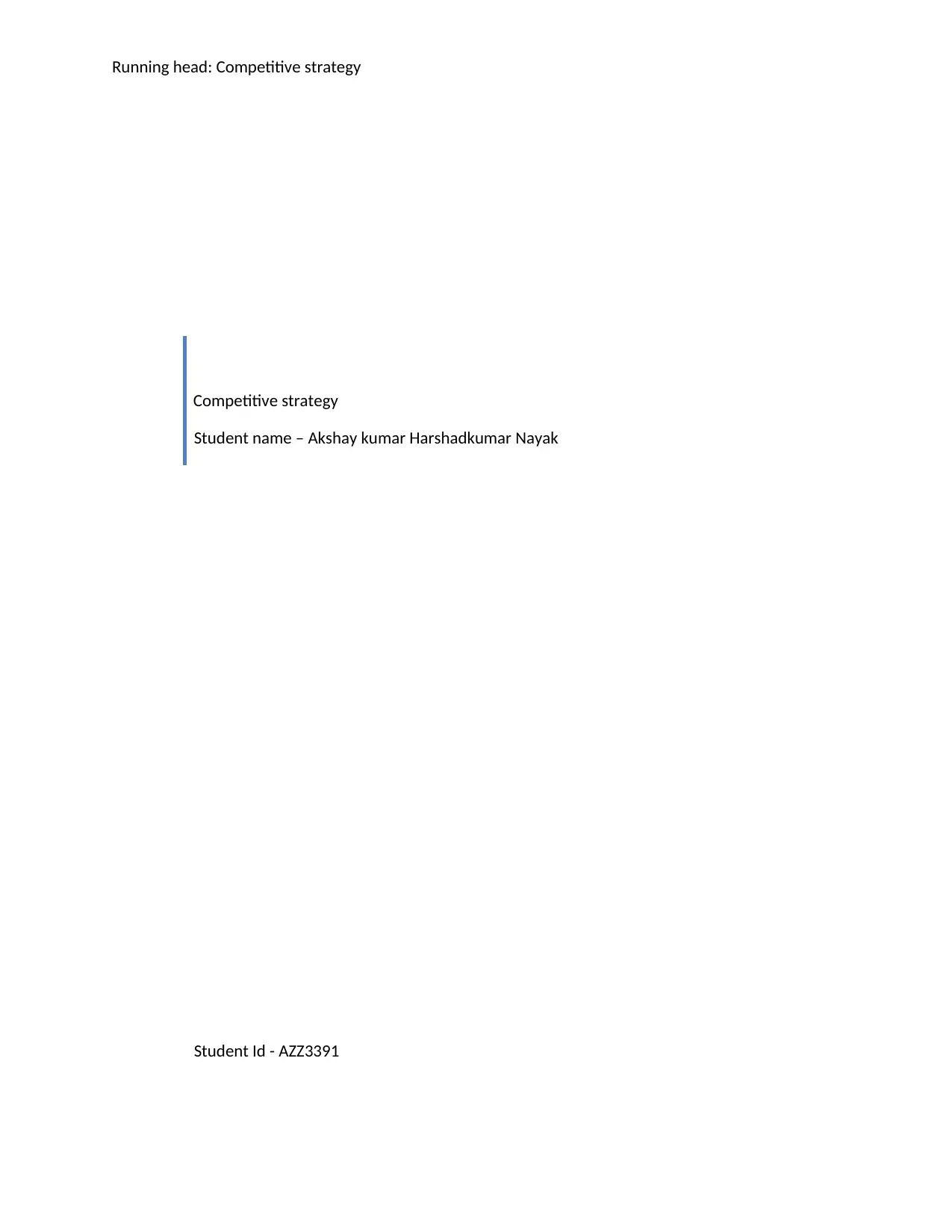
Running head: Competitive strategy
Competitive strategy
Student name – Akshay kumar Harshadkumar Nayak
Student Id - AZZ3391
Competitive strategy
Student name – Akshay kumar Harshadkumar Nayak
Student Id - AZZ3391
Paraphrase This Document
Need a fresh take? Get an instant paraphrase of this document with our AI Paraphraser
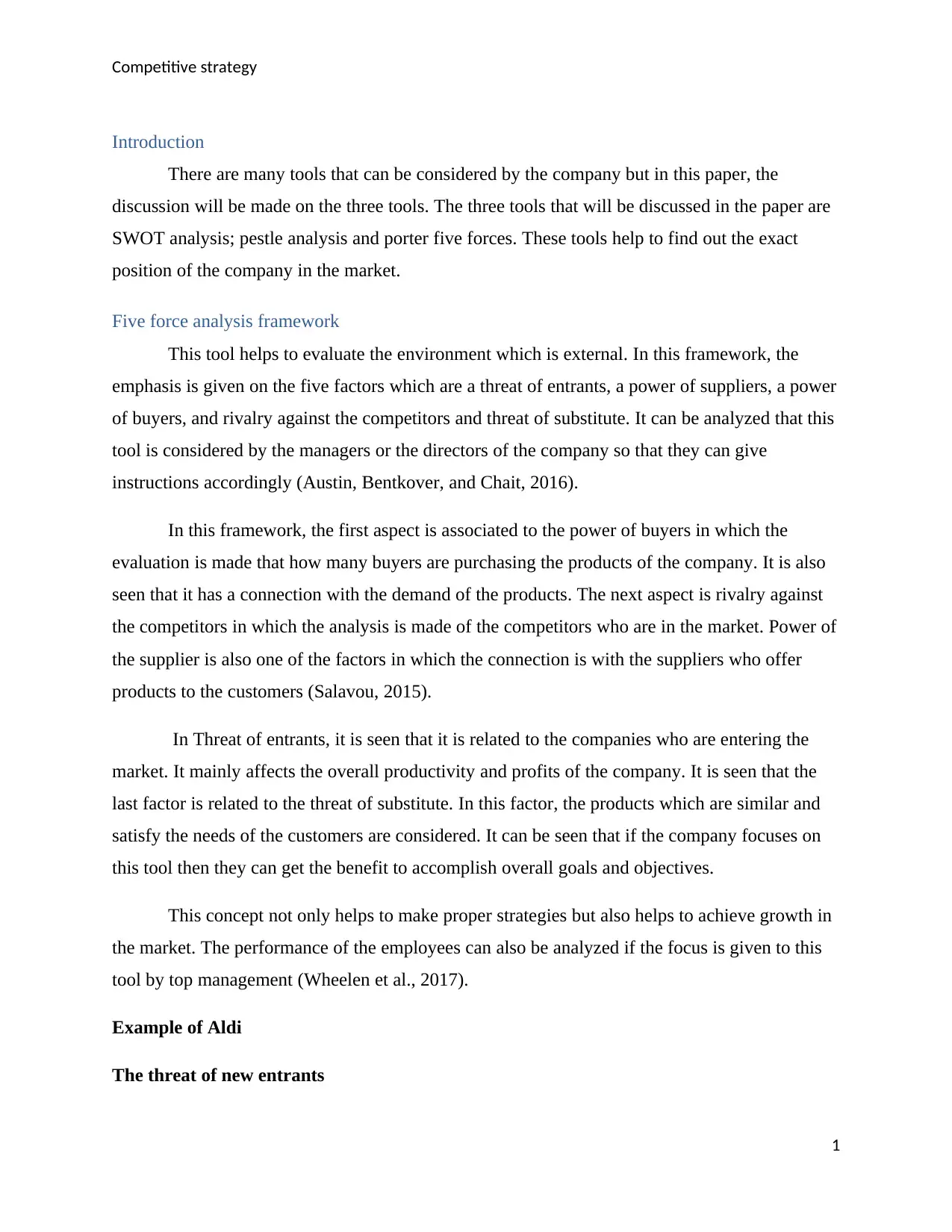
Competitive strategy
Introduction
There are many tools that can be considered by the company but in this paper, the
discussion will be made on the three tools. The three tools that will be discussed in the paper are
SWOT analysis; pestle analysis and porter five forces. These tools help to find out the exact
position of the company in the market.
Five force analysis framework
This tool helps to evaluate the environment which is external. In this framework, the
emphasis is given on the five factors which are a threat of entrants, a power of suppliers, a power
of buyers, and rivalry against the competitors and threat of substitute. It can be analyzed that this
tool is considered by the managers or the directors of the company so that they can give
instructions accordingly (Austin, Bentkover, and Chait, 2016).
In this framework, the first aspect is associated to the power of buyers in which the
evaluation is made that how many buyers are purchasing the products of the company. It is also
seen that it has a connection with the demand of the products. The next aspect is rivalry against
the competitors in which the analysis is made of the competitors who are in the market. Power of
the supplier is also one of the factors in which the connection is with the suppliers who offer
products to the customers (Salavou, 2015).
In Threat of entrants, it is seen that it is related to the companies who are entering the
market. It mainly affects the overall productivity and profits of the company. It is seen that the
last factor is related to the threat of substitute. In this factor, the products which are similar and
satisfy the needs of the customers are considered. It can be seen that if the company focuses on
this tool then they can get the benefit to accomplish overall goals and objectives.
This concept not only helps to make proper strategies but also helps to achieve growth in
the market. The performance of the employees can also be analyzed if the focus is given to this
tool by top management (Wheelen et al., 2017).
Example of Aldi
The threat of new entrants
1
Introduction
There are many tools that can be considered by the company but in this paper, the
discussion will be made on the three tools. The three tools that will be discussed in the paper are
SWOT analysis; pestle analysis and porter five forces. These tools help to find out the exact
position of the company in the market.
Five force analysis framework
This tool helps to evaluate the environment which is external. In this framework, the
emphasis is given on the five factors which are a threat of entrants, a power of suppliers, a power
of buyers, and rivalry against the competitors and threat of substitute. It can be analyzed that this
tool is considered by the managers or the directors of the company so that they can give
instructions accordingly (Austin, Bentkover, and Chait, 2016).
In this framework, the first aspect is associated to the power of buyers in which the
evaluation is made that how many buyers are purchasing the products of the company. It is also
seen that it has a connection with the demand of the products. The next aspect is rivalry against
the competitors in which the analysis is made of the competitors who are in the market. Power of
the supplier is also one of the factors in which the connection is with the suppliers who offer
products to the customers (Salavou, 2015).
In Threat of entrants, it is seen that it is related to the companies who are entering the
market. It mainly affects the overall productivity and profits of the company. It is seen that the
last factor is related to the threat of substitute. In this factor, the products which are similar and
satisfy the needs of the customers are considered. It can be seen that if the company focuses on
this tool then they can get the benefit to accomplish overall goals and objectives.
This concept not only helps to make proper strategies but also helps to achieve growth in
the market. The performance of the employees can also be analyzed if the focus is given to this
tool by top management (Wheelen et al., 2017).
Example of Aldi
The threat of new entrants
1
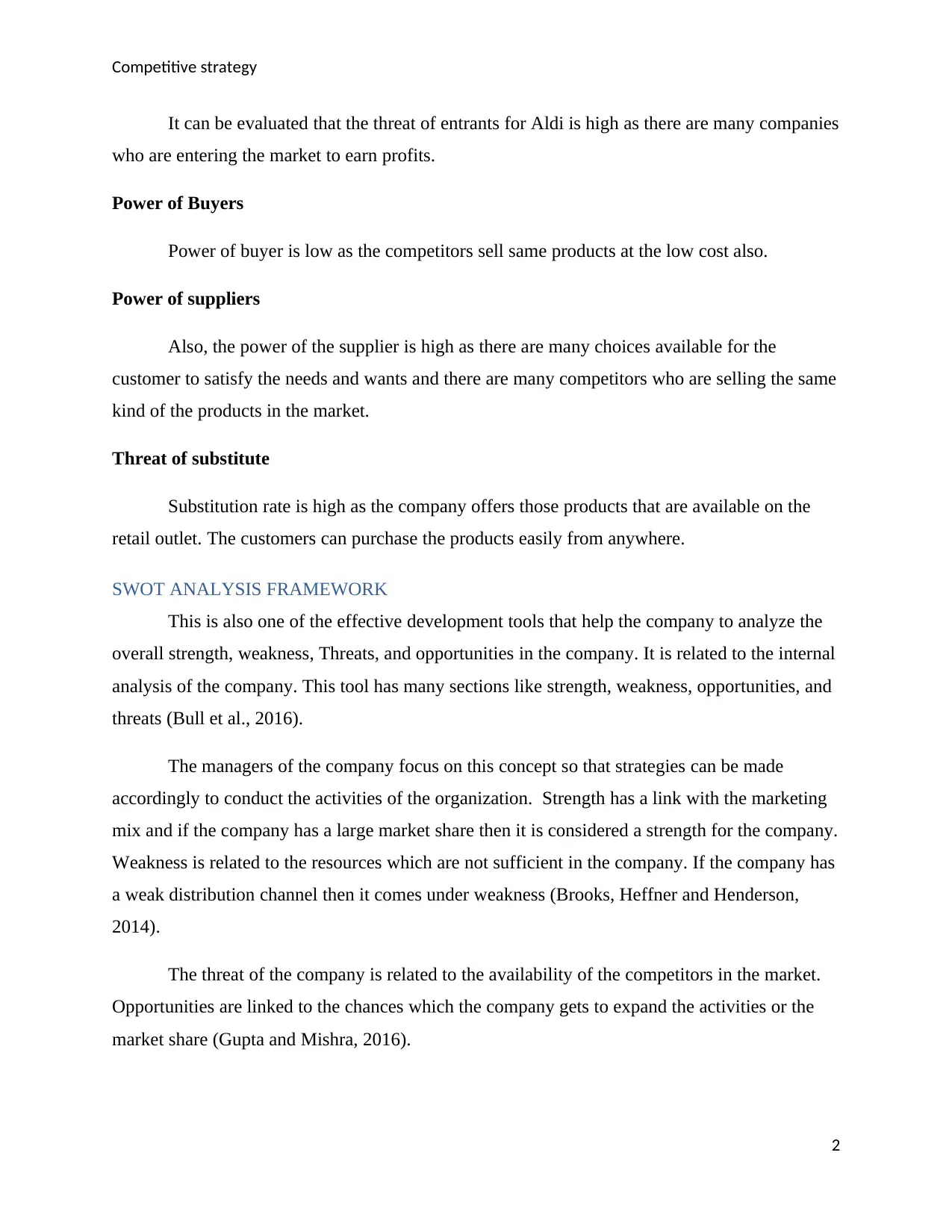
Competitive strategy
It can be evaluated that the threat of entrants for Aldi is high as there are many companies
who are entering the market to earn profits.
Power of Buyers
Power of buyer is low as the competitors sell same products at the low cost also.
Power of suppliers
Also, the power of the supplier is high as there are many choices available for the
customer to satisfy the needs and wants and there are many competitors who are selling the same
kind of the products in the market.
Threat of substitute
Substitution rate is high as the company offers those products that are available on the
retail outlet. The customers can purchase the products easily from anywhere.
SWOT ANALYSIS FRAMEWORK
This is also one of the effective development tools that help the company to analyze the
overall strength, weakness, Threats, and opportunities in the company. It is related to the internal
analysis of the company. This tool has many sections like strength, weakness, opportunities, and
threats (Bull et al., 2016).
The managers of the company focus on this concept so that strategies can be made
accordingly to conduct the activities of the organization. Strength has a link with the marketing
mix and if the company has a large market share then it is considered a strength for the company.
Weakness is related to the resources which are not sufficient in the company. If the company has
a weak distribution channel then it comes under weakness (Brooks, Heffner and Henderson,
2014).
The threat of the company is related to the availability of the competitors in the market.
Opportunities are linked to the chances which the company gets to expand the activities or the
market share (Gupta and Mishra, 2016).
2
It can be evaluated that the threat of entrants for Aldi is high as there are many companies
who are entering the market to earn profits.
Power of Buyers
Power of buyer is low as the competitors sell same products at the low cost also.
Power of suppliers
Also, the power of the supplier is high as there are many choices available for the
customer to satisfy the needs and wants and there are many competitors who are selling the same
kind of the products in the market.
Threat of substitute
Substitution rate is high as the company offers those products that are available on the
retail outlet. The customers can purchase the products easily from anywhere.
SWOT ANALYSIS FRAMEWORK
This is also one of the effective development tools that help the company to analyze the
overall strength, weakness, Threats, and opportunities in the company. It is related to the internal
analysis of the company. This tool has many sections like strength, weakness, opportunities, and
threats (Bull et al., 2016).
The managers of the company focus on this concept so that strategies can be made
accordingly to conduct the activities of the organization. Strength has a link with the marketing
mix and if the company has a large market share then it is considered a strength for the company.
Weakness is related to the resources which are not sufficient in the company. If the company has
a weak distribution channel then it comes under weakness (Brooks, Heffner and Henderson,
2014).
The threat of the company is related to the availability of the competitors in the market.
Opportunities are linked to the chances which the company gets to expand the activities or the
market share (Gupta and Mishra, 2016).
2
⊘ This is a preview!⊘
Do you want full access?
Subscribe today to unlock all pages.

Trusted by 1+ million students worldwide
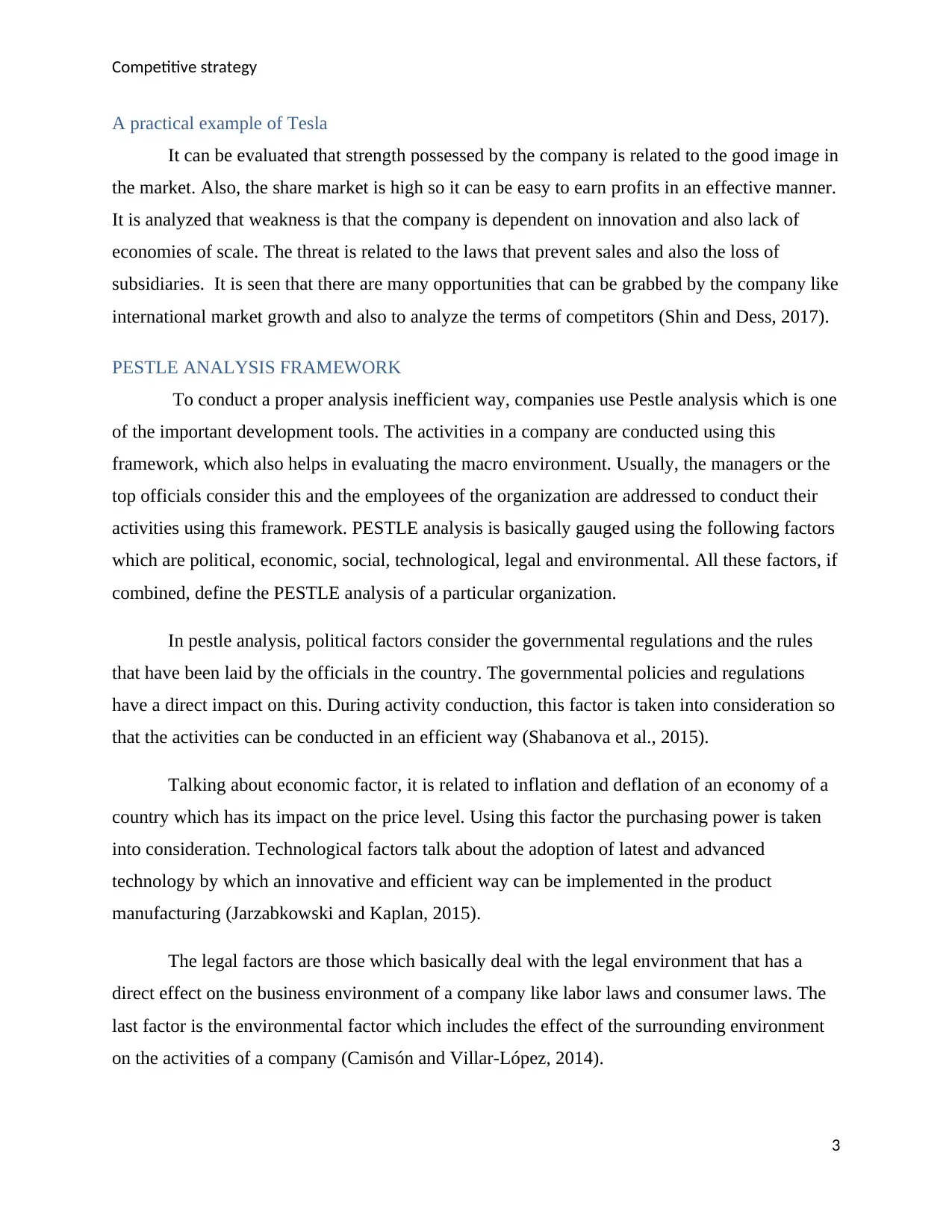
Competitive strategy
A practical example of Tesla
It can be evaluated that strength possessed by the company is related to the good image in
the market. Also, the share market is high so it can be easy to earn profits in an effective manner.
It is analyzed that weakness is that the company is dependent on innovation and also lack of
economies of scale. The threat is related to the laws that prevent sales and also the loss of
subsidiaries. It is seen that there are many opportunities that can be grabbed by the company like
international market growth and also to analyze the terms of competitors (Shin and Dess, 2017).
PESTLE ANALYSIS FRAMEWORK
To conduct a proper analysis inefficient way, companies use Pestle analysis which is one
of the important development tools. The activities in a company are conducted using this
framework, which also helps in evaluating the macro environment. Usually, the managers or the
top officials consider this and the employees of the organization are addressed to conduct their
activities using this framework. PESTLE analysis is basically gauged using the following factors
which are political, economic, social, technological, legal and environmental. All these factors, if
combined, define the PESTLE analysis of a particular organization.
In pestle analysis, political factors consider the governmental regulations and the rules
that have been laid by the officials in the country. The governmental policies and regulations
have a direct impact on this. During activity conduction, this factor is taken into consideration so
that the activities can be conducted in an efficient way (Shabanova et al., 2015).
Talking about economic factor, it is related to inflation and deflation of an economy of a
country which has its impact on the price level. Using this factor the purchasing power is taken
into consideration. Technological factors talk about the adoption of latest and advanced
technology by which an innovative and efficient way can be implemented in the product
manufacturing (Jarzabkowski and Kaplan, 2015).
The legal factors are those which basically deal with the legal environment that has a
direct effect on the business environment of a company like labor laws and consumer laws. The
last factor is the environmental factor which includes the effect of the surrounding environment
on the activities of a company (Camisón and Villar-López, 2014).
3
A practical example of Tesla
It can be evaluated that strength possessed by the company is related to the good image in
the market. Also, the share market is high so it can be easy to earn profits in an effective manner.
It is analyzed that weakness is that the company is dependent on innovation and also lack of
economies of scale. The threat is related to the laws that prevent sales and also the loss of
subsidiaries. It is seen that there are many opportunities that can be grabbed by the company like
international market growth and also to analyze the terms of competitors (Shin and Dess, 2017).
PESTLE ANALYSIS FRAMEWORK
To conduct a proper analysis inefficient way, companies use Pestle analysis which is one
of the important development tools. The activities in a company are conducted using this
framework, which also helps in evaluating the macro environment. Usually, the managers or the
top officials consider this and the employees of the organization are addressed to conduct their
activities using this framework. PESTLE analysis is basically gauged using the following factors
which are political, economic, social, technological, legal and environmental. All these factors, if
combined, define the PESTLE analysis of a particular organization.
In pestle analysis, political factors consider the governmental regulations and the rules
that have been laid by the officials in the country. The governmental policies and regulations
have a direct impact on this. During activity conduction, this factor is taken into consideration so
that the activities can be conducted in an efficient way (Shabanova et al., 2015).
Talking about economic factor, it is related to inflation and deflation of an economy of a
country which has its impact on the price level. Using this factor the purchasing power is taken
into consideration. Technological factors talk about the adoption of latest and advanced
technology by which an innovative and efficient way can be implemented in the product
manufacturing (Jarzabkowski and Kaplan, 2015).
The legal factors are those which basically deal with the legal environment that has a
direct effect on the business environment of a company like labor laws and consumer laws. The
last factor is the environmental factor which includes the effect of the surrounding environment
on the activities of a company (Camisón and Villar-López, 2014).
3
Paraphrase This Document
Need a fresh take? Get an instant paraphrase of this document with our AI Paraphraser
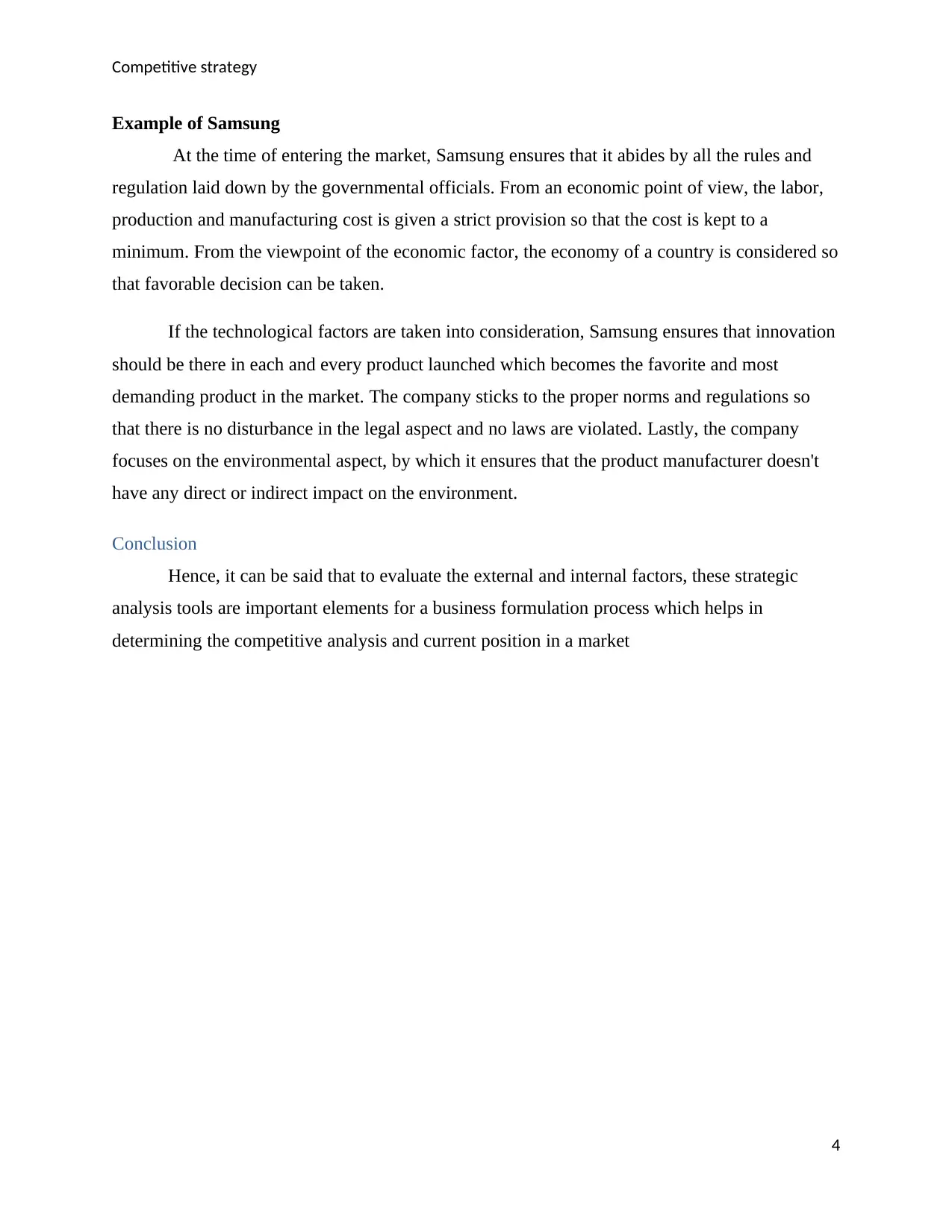
Competitive strategy
Example of Samsung
At the time of entering the market, Samsung ensures that it abides by all the rules and
regulation laid down by the governmental officials. From an economic point of view, the labor,
production and manufacturing cost is given a strict provision so that the cost is kept to a
minimum. From the viewpoint of the economic factor, the economy of a country is considered so
that favorable decision can be taken.
If the technological factors are taken into consideration, Samsung ensures that innovation
should be there in each and every product launched which becomes the favorite and most
demanding product in the market. The company sticks to the proper norms and regulations so
that there is no disturbance in the legal aspect and no laws are violated. Lastly, the company
focuses on the environmental aspect, by which it ensures that the product manufacturer doesn't
have any direct or indirect impact on the environment.
Conclusion
Hence, it can be said that to evaluate the external and internal factors, these strategic
analysis tools are important elements for a business formulation process which helps in
determining the competitive analysis and current position in a market
4
Example of Samsung
At the time of entering the market, Samsung ensures that it abides by all the rules and
regulation laid down by the governmental officials. From an economic point of view, the labor,
production and manufacturing cost is given a strict provision so that the cost is kept to a
minimum. From the viewpoint of the economic factor, the economy of a country is considered so
that favorable decision can be taken.
If the technological factors are taken into consideration, Samsung ensures that innovation
should be there in each and every product launched which becomes the favorite and most
demanding product in the market. The company sticks to the proper norms and regulations so
that there is no disturbance in the legal aspect and no laws are violated. Lastly, the company
focuses on the environmental aspect, by which it ensures that the product manufacturer doesn't
have any direct or indirect impact on the environment.
Conclusion
Hence, it can be said that to evaluate the external and internal factors, these strategic
analysis tools are important elements for a business formulation process which helps in
determining the competitive analysis and current position in a market
4
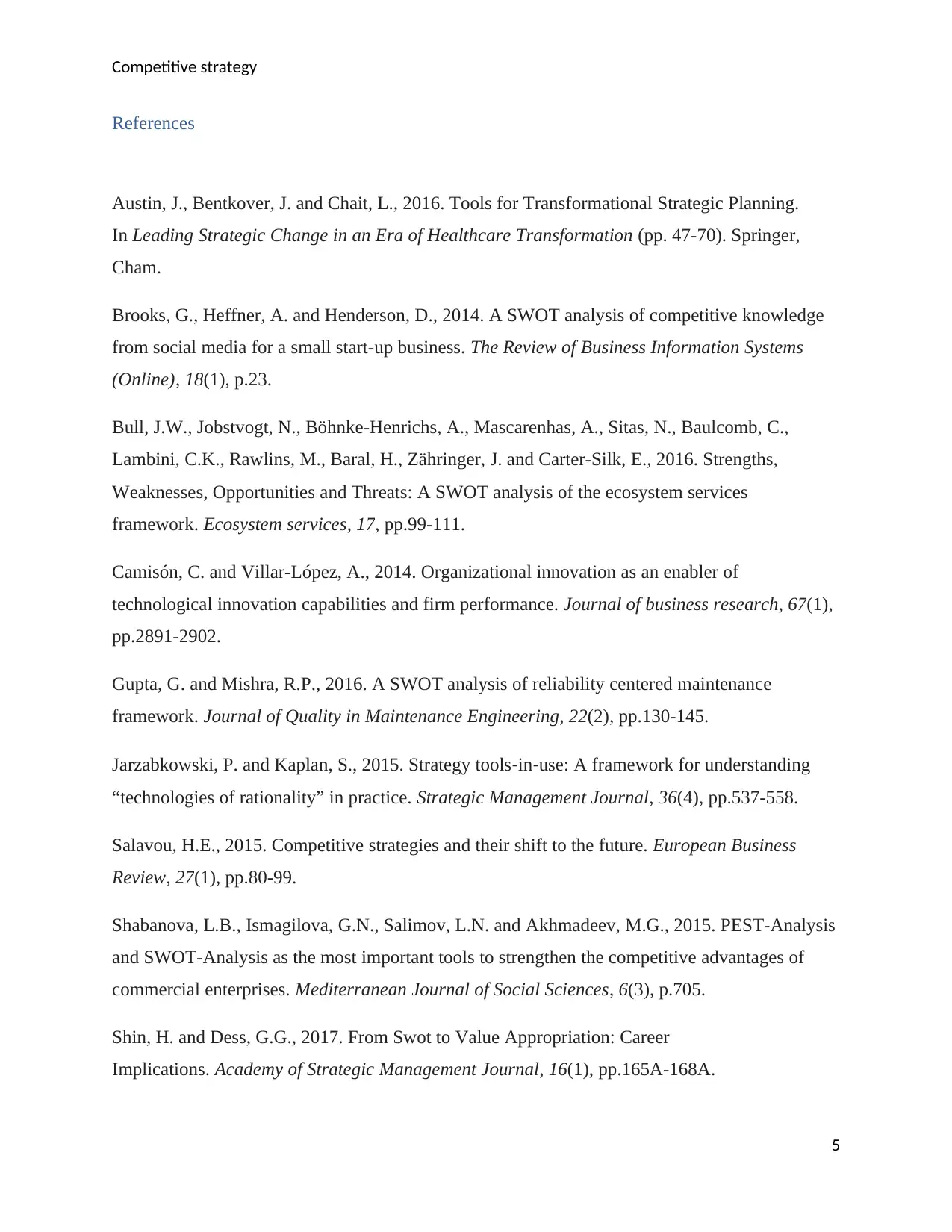
Competitive strategy
References
Austin, J., Bentkover, J. and Chait, L., 2016. Tools for Transformational Strategic Planning.
In Leading Strategic Change in an Era of Healthcare Transformation (pp. 47-70). Springer,
Cham.
Brooks, G., Heffner, A. and Henderson, D., 2014. A SWOT analysis of competitive knowledge
from social media for a small start-up business. The Review of Business Information Systems
(Online), 18(1), p.23.
Bull, J.W., Jobstvogt, N., Böhnke-Henrichs, A., Mascarenhas, A., Sitas, N., Baulcomb, C.,
Lambini, C.K., Rawlins, M., Baral, H., Zähringer, J. and Carter-Silk, E., 2016. Strengths,
Weaknesses, Opportunities and Threats: A SWOT analysis of the ecosystem services
framework. Ecosystem services, 17, pp.99-111.
Camisón, C. and Villar-López, A., 2014. Organizational innovation as an enabler of
technological innovation capabilities and firm performance. Journal of business research, 67(1),
pp.2891-2902.
Gupta, G. and Mishra, R.P., 2016. A SWOT analysis of reliability centered maintenance
framework. Journal of Quality in Maintenance Engineering, 22(2), pp.130-145.
Jarzabkowski, P. and Kaplan, S., 2015. Strategy tools‐in‐use: A framework for understanding
“technologies of rationality” in practice. Strategic Management Journal, 36(4), pp.537-558.
Salavou, H.E., 2015. Competitive strategies and their shift to the future. European Business
Review, 27(1), pp.80-99.
Shabanova, L.B., Ismagilova, G.N., Salimov, L.N. and Akhmadeev, M.G., 2015. PEST-Analysis
and SWOT-Analysis as the most important tools to strengthen the competitive advantages of
commercial enterprises. Mediterranean Journal of Social Sciences, 6(3), p.705.
Shin, H. and Dess, G.G., 2017. From Swot to Value Appropriation: Career
Implications. Academy of Strategic Management Journal, 16(1), pp.165A-168A.
5
References
Austin, J., Bentkover, J. and Chait, L., 2016. Tools for Transformational Strategic Planning.
In Leading Strategic Change in an Era of Healthcare Transformation (pp. 47-70). Springer,
Cham.
Brooks, G., Heffner, A. and Henderson, D., 2014. A SWOT analysis of competitive knowledge
from social media for a small start-up business. The Review of Business Information Systems
(Online), 18(1), p.23.
Bull, J.W., Jobstvogt, N., Böhnke-Henrichs, A., Mascarenhas, A., Sitas, N., Baulcomb, C.,
Lambini, C.K., Rawlins, M., Baral, H., Zähringer, J. and Carter-Silk, E., 2016. Strengths,
Weaknesses, Opportunities and Threats: A SWOT analysis of the ecosystem services
framework. Ecosystem services, 17, pp.99-111.
Camisón, C. and Villar-López, A., 2014. Organizational innovation as an enabler of
technological innovation capabilities and firm performance. Journal of business research, 67(1),
pp.2891-2902.
Gupta, G. and Mishra, R.P., 2016. A SWOT analysis of reliability centered maintenance
framework. Journal of Quality in Maintenance Engineering, 22(2), pp.130-145.
Jarzabkowski, P. and Kaplan, S., 2015. Strategy tools‐in‐use: A framework for understanding
“technologies of rationality” in practice. Strategic Management Journal, 36(4), pp.537-558.
Salavou, H.E., 2015. Competitive strategies and their shift to the future. European Business
Review, 27(1), pp.80-99.
Shabanova, L.B., Ismagilova, G.N., Salimov, L.N. and Akhmadeev, M.G., 2015. PEST-Analysis
and SWOT-Analysis as the most important tools to strengthen the competitive advantages of
commercial enterprises. Mediterranean Journal of Social Sciences, 6(3), p.705.
Shin, H. and Dess, G.G., 2017. From Swot to Value Appropriation: Career
Implications. Academy of Strategic Management Journal, 16(1), pp.165A-168A.
5
⊘ This is a preview!⊘
Do you want full access?
Subscribe today to unlock all pages.

Trusted by 1+ million students worldwide
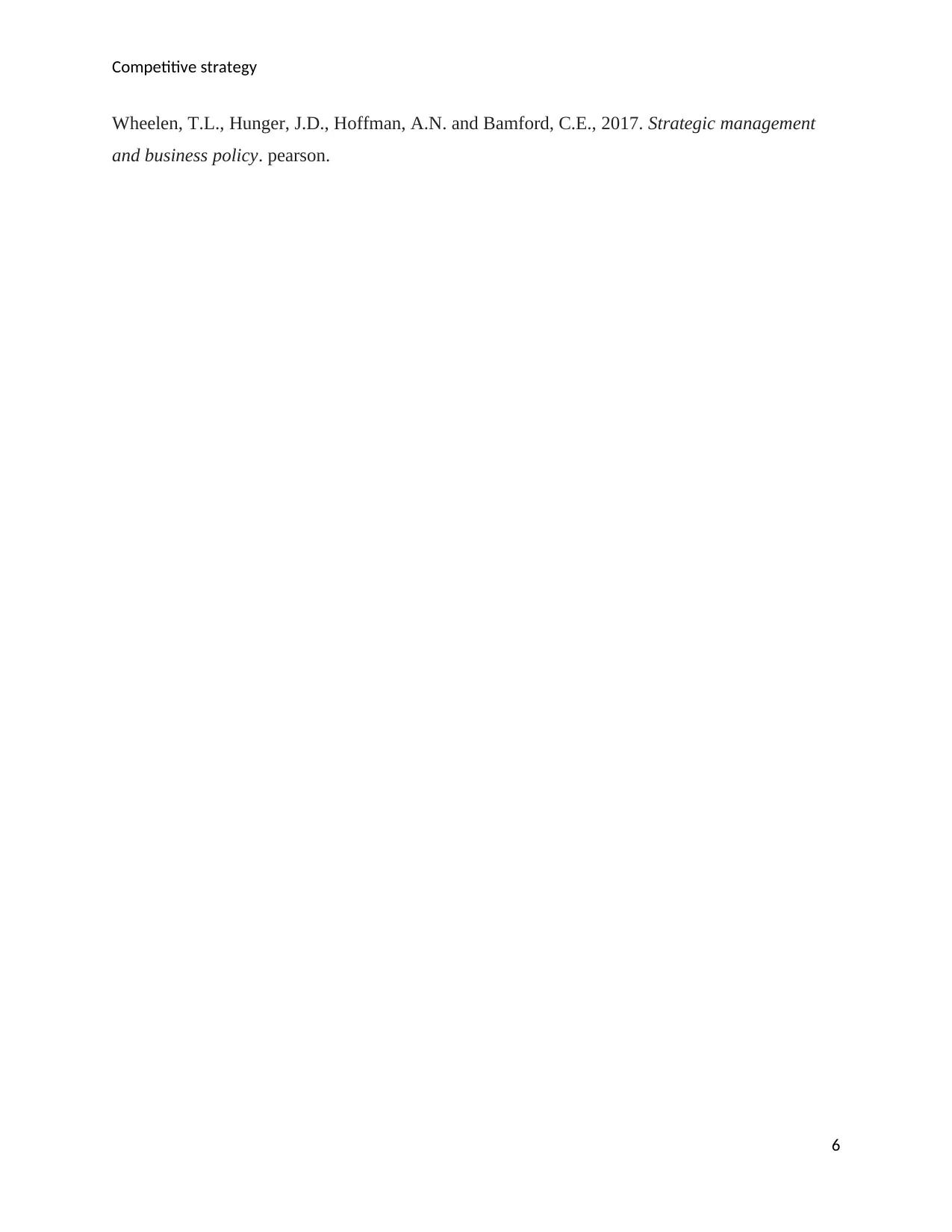
Competitive strategy
Wheelen, T.L., Hunger, J.D., Hoffman, A.N. and Bamford, C.E., 2017. Strategic management
and business policy. pearson.
6
Wheelen, T.L., Hunger, J.D., Hoffman, A.N. and Bamford, C.E., 2017. Strategic management
and business policy. pearson.
6
1 out of 7
Related Documents
Your All-in-One AI-Powered Toolkit for Academic Success.
+13062052269
info@desklib.com
Available 24*7 on WhatsApp / Email
![[object Object]](/_next/static/media/star-bottom.7253800d.svg)
Unlock your academic potential
Copyright © 2020–2025 A2Z Services. All Rights Reserved. Developed and managed by ZUCOL.



